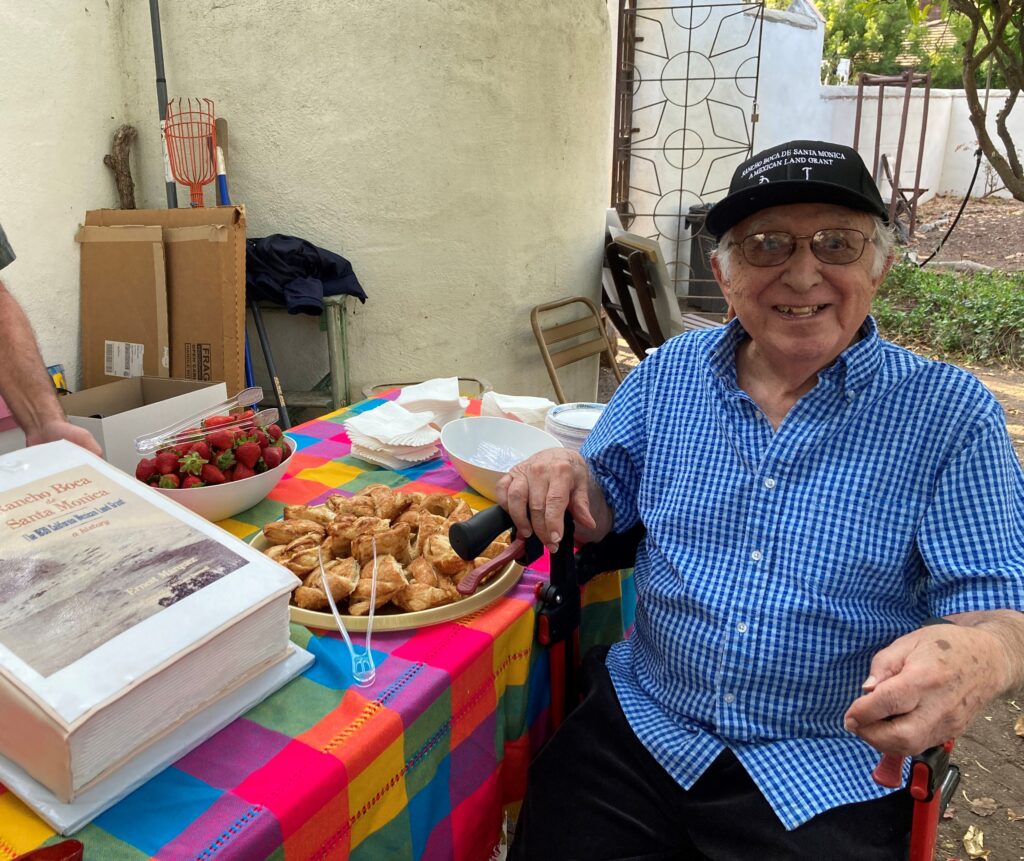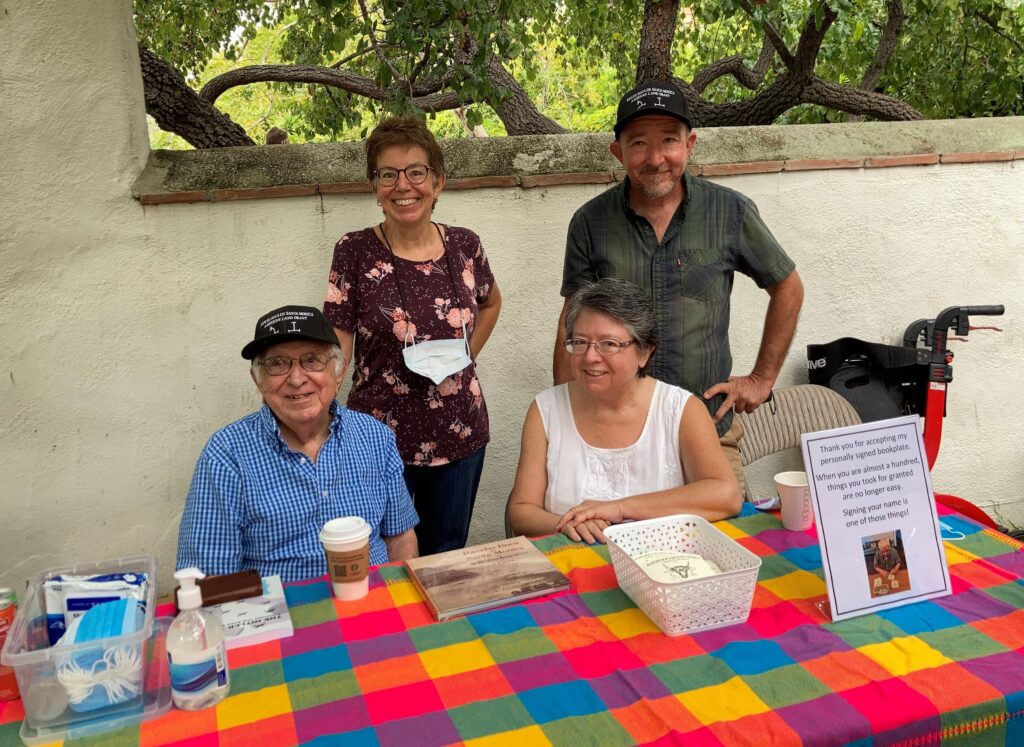
Ernie Marquez, 97, with a cake facsimile of his book.
Photo: Libby Motika
By LIBBY MOTIKA
Circling the News Contributor
While most of us lesser lights lack the celebrity status needed to earn Henry Louis Gates’ search for ancestral stories in the PBS series “Finding Your Roots,” there is one local family that through the prodigious research of one man possesses not only the story of their forefathers, but also the history of early California. That man is Ernest Marquez.
 Ernie is the lineal descendant of Mexican land-grant ranchers who owned the 6,650-acre Rancho Boca de Santa Monica, now encompassing large swaths of Santa Monica, Pacific Palisades and Topanga Canyon. His decades-long pursuit of his family’s history has resulted in the long-awaited publication of his book, “Rancho Boca de Santa Monica: The 1839 California Mexican Land Grant, A History.”
Ernie is the lineal descendant of Mexican land-grant ranchers who owned the 6,650-acre Rancho Boca de Santa Monica, now encompassing large swaths of Santa Monica, Pacific Palisades and Topanga Canyon. His decades-long pursuit of his family’s history has resulted in the long-awaited publication of his book, “Rancho Boca de Santa Monica: The 1839 California Mexican Land Grant, A History.”
Born in 1924 (near Canyon Elementary School), Ernie grew up on ranch land in Santa Monica Canyon, which by that time had been sold off by his ancestors. While career and family life took him away from his beloved canyon, he harbored a deep-seated curiosity about his family and his place in the world.
Although an amateur historian, Ernie applied curiosity, doggedness, study and sleuthing to complete the picture of his family. He gathered material culture, documents and photographs that he unearthed in swap meets, estate sales and other collections. He studied genealogy to understand his extended family tree and successive regimes that occupied the land: New Spain, the Republic of Mexico and finally the United States. He was able to access special collections at UCLA, USC and Berkeley’s Bancroft, which is devoted to California history.
In his quest for researching California history, Ernie has written several books, including “Port Los Angeles: A Phenomenon of the Railroad; Santa Monica Beach: A Collector’s Pictorial History” and “Noir Afloat: Tony Cornero and the Notorious Gambling Ships of Southern California.”
In 1838, Ernie’s great-grandfather, Francisco Marquez, and Ysidro Reyes a neighbor in the Pueblo de Los Angeles, applied for title to Rancho Boca de Santa Monica. To qualify for a tract of land, an applicant had to submit a petition, which required a hand-drawn map showing the boundaries of the desired land. In addition, the petitioner had to be a Mexican citizen of good character, Catholic and agree to build a house, plant fruit trees on the land and stock the rancho with at least 150 head of cattle.
Marquez, his wife, Roque Valenzuela, and their son, Manuel, moved to Santa Monica Canyon, where he built an adobe house on the upper mesa — the first permanent structure built in the canyon. There, he opened a blacksmith shop and continued to work the rancho until his death in 1850. He and Roque had 11 children.
Reyes found a suitable location for his home on the canyon’s rim near what is now 7th Street and Adelaide Drive. Like his partner, Reyes had a big family, raising 11 children with his wife, Maria Antonia.

Ernie Marquez with his three children, Monica, Eileen and Ernesto during the celebration for Ernie’s book at the Marquez Family Cemetery in Santa Monica Canyon.
Photo: Libby Motika
In his book, Ernie adds factual and fascinating commentary on rancho life, even including many colorful handed-down tales. Accompanied by over 100 photos and documents from the Ernest Marquez Archive at the Huntington Library, the text describes how the slow dissolution of the once vast rancho began accelerating as the area — once considered the hinterlands — gained value for recreation and real estate development.
The completion of Ernie’s 50-year project was recently celebrated, appropriately, at the small Marquez Family Cemetery, a remnant of the original land grant located on San Lorenzo in Santa Monica Canyon.
A gathering of family and friends rejoiced with Ernie, now 97, who sat at a table under a shade tree, with boxes of autographed books nearby. Descendants of the Marquez and Reyes families, including Ernie’s three children Ernesto, Monica and Eileen, along with aunts, uncles, cousins and eighth-generation children greeted neighbors and admirers.
“Descendants from all walks of life come here for many reasons,” writes Ernie in the Epilogue, describing the cemetery. “They have a beloved ancestor buried here. They want their children to learn about their family heritage. Everyone has a unique, colorful story about their aunt or uncle who did this or that back in their days on the rancho. Within these white adobe walls one can see, smell and feel the natural beauty of Santa Monica Canyon, and hear the gentle, distant voices of those who have called it home through the centuries.”
This book is not sold in stores; order online from Angel City Press, angelcitypress.com.

Eighth generation descendants of Bonifacio Marquez, from left, Andrew, Ashley and Audrey Kilbride.
Photo: Libby Motika

I’ve been waiting for years for this book to be published, and I absolutely love it. What a treat to learn about the place I was born in in the 1950’s.
Thanks so much Mr. Marquez.
While working at VAMC West LA 1980-81, I personally met an Elderly man, and patient on my ward. In my twenties then I had a delightful conversation with him and another family member reminiscing the history and the connection between our families. My father Moises Gallardo, son of Candelario grew up in Santa Monica. My father was close friends to Leo Marquez. As a child I met him with his wife Clara. The elder Marquez was so kind to dedicate his book to me “Rancho Boca de Santa Monica” authored by Daniel Marquez. It’s been years since our conversation but I recall his kind sweet spirit that seemed to gleam through his smile. I t was shortly before his death and left me feeling blessed to have met him.
Impressed by your involvement with the Marquez Cementery; my husband is a Marquez; descendent of Ampelio Marquez who was son of Pablo Marquez. Do you have any names from your family tree? I would like to know if there is a connection. My father-in-law was from San Julian, Jalisco and his mother was Bernardina Munoz.
Will visit the cemetery as soon as we can.